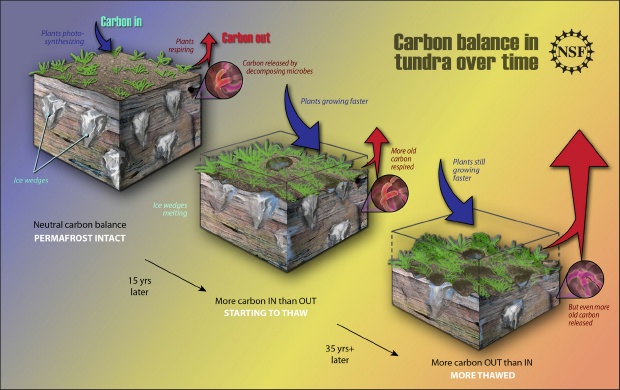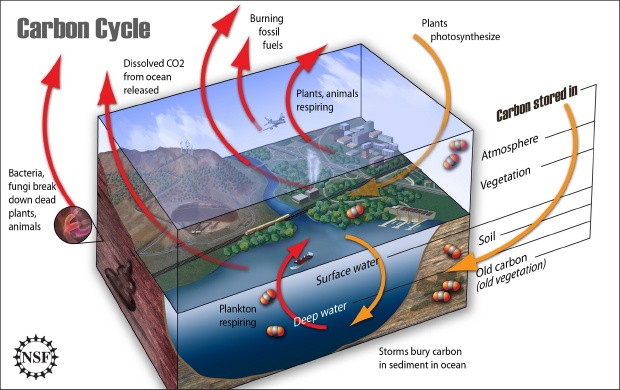A large amount of organic carbon in the tundra is stored in the soil and permafrost. This pool of carbon, deposited over thousands of years, remains locked in the perennially frozen ground. In recent years this area began to thaw, providing increased access to plants and microbes that could shift the carbon from the land to the atmosphere.
An understanding of the rate of carbon release is necessary to estimate the strength of positive feedback to climate change, a likely consequence of permafrost thaw. Scientists use the term positive feedback to describe the snowball effect described here: a warmer climate permits permafrost thaw, releasing more carbon into the atmosphere, which will further increase global surface temperature.

A lot of old carbon is stored deep in the tundra where it is locked in permafrost. As these areas start to thaw over about 15 years, large ice wedges in the soil get smaller causing pot-holing and soil depression. The newly available water prompts faster plant growth, and the carbon taken out of the atmosphere by the plants photosynthesizing is greater than the carbon released back into the atmosphere by plants respiring and microbes decomposing carbon. However, after about 50 years, as thawing continues and the soil settles even more, plants are growing faster yet, however the rate of plant respiration and old carbon release through microbes grows even bigger netting more carbon out into the atmosphere than into the soil. Credit: Zina Deretsky, National Science Foundation
"In earlier work we estimated that widespread permafrost thaw could potentially release 0.8-1.1 gigatons of carbon per year," said Ted Schuur an ecologist at the University of Florida and the lead author of the study. "Before this study, we didn't know how fast that carbon could potentially be released from permafrost, and how this feedback to climate would change over time."
From 2004 to 2006, Schuur and his team used radiocarbon dating, a technique typically used to determine the age of artifacts, to track the movement of "old" organic carbon accumulated within the soils and permafrost at an Alaskan site. The ability to distinguish old carbon from newer carbon allowed the researchers to track current metabolism of old carbon in an area where permafrost thaw is increasing.
Surprisingly, this research revealed that during the initial stages of permafrost thaw, plant growth and photosynthesis, which remove carbon from the atmosphere, increase. This increase offsets the release of old carbon from thawing. However, sustained thaw eventually releases more carbon than plants can uptake, overwhelming their compensatory capacities. To put this in a global context, if the average global temperature continues to rise, current calculations predict that positive feedback from permafrost thaw could annually add as much carbon to the atmosphere as another significant source, land use change.

Carbon is stored in the atmosphere, vegetation, soil, deep layers of the crust and in surface and deep water. A few of the mechanisms of bringing carbon into the system are plants photsynthesizing, and storms carying sediment down into the ocean. Decomposition by fungi and bacteria, plants and animals respiring, burning fossil fuels and carbon dioxide dissolving off of the ocean are some of the mechanisms that release carbon back out. Credit: Zina Deretsky, National Science Foundation
The Alaskan site where Schuur and colleagues carried out their research was monitored over the past two decades, with permafrost temperature measurements beginning before the permafrost began to thaw. This detailed record coupled with Schuur's study of ecosystem carbon exchange and old carbon release provide a comprehensive picture of the dynamics of carbon exchange in response to permafrost thaw.
"Records from this site exist on a decadal time scale, meaning we are able to more accurately account for the slow pace of change within the system. Overall, this research documents the long-term plant and soil changes that occur as permafrost thaws, thus providing a basis for making long term predictions about ecosystem carbon balance with increased confidence," Schuur reported.





Comments